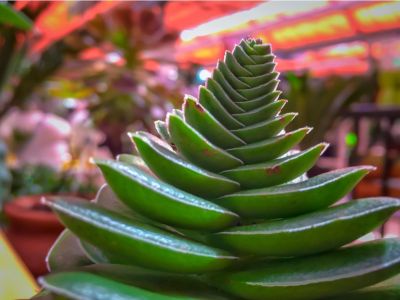Red Pagoda Crassula
Succulents offer a wide range of form to suit any discernible gardener. The Crassula genus has over 150 different species, each more surprising than the last. The fairly common jade plant is in the genus. Crassula pagoda plants have an even more diverse “wow” factor. The stacked triangular foliage edged with red and fine prickly spines is eye candy for the succulent enthusiast. Growing Crassula Red Pagoda is a must for the gardener crazy about succulents and collecting. Red Pagoda (Crassula corymbulosa) grows spirally arranged, with thick, fleshy leaves bordered with bright pink, red, or sometimes orange. Once you get over the color, the geometric arrangement of the leaves will astound and amaze you. The effect of the layered leaves is hard to describe without invoking artistic expression. Each new rosette of leaves grows on top of an older rosette. The new leaves are mostly green and small but they get larger and larger with brighter colors as you view down the plant’s stem. The effect is almost an optical illusion of looking into a deeply hued, ribbed tunnel. The plant is also called shark’s tooth due to the triangular serrated pads.
How to Grow Red Pagoda
Soil, light, and air circulation are key needs for growing Crassula Red Pagoda. The stems are initially erect but over time, as new rosettes form, they will begin to trail. This means you can grow the plant in a hanging basket. It is equally at home in a rockery, clay pot, or amongst a display of other succulents in the garden. Red Pagoda is only hardy in United States Department of Agriculture zones 11 to 12 but it performs well as a houseplant, too. Plants prefer well-drained soil with plenty of grit but can survive in amended clay soil. Like most succulents, Red Pagoda is easy to grow from cuttings. Allow the cutting to callus for a few days and insert into a soilless medium. In a month or so, the plant will root and can be transplanted to a display container or the garden.
Caring for Crassula Succulents
Red Pagoda gets its deepest, most vibrant color in winter in a bright location. Plants located in sun develop hues that are rich and jewel-like. The plant has low water needs but it is best to follow a regular schedule of watering in the first year to force a vigorous root system. Red Pagoda is both deer and rabbit resistant, thrives in drought conditions for short periods of time, can perform well in either full or partial sun, and has low nutrient requirements. About the only thing that will kill the plant is overwatering, which causes root rot, and a few pests such as mealybugs and aphids. Remove the spent leaves to preserve the best appearance. Lazy gardeners will love caring for Crassula succulents due to their unfussy natures. Good care may see you rewarded in summer with lovely, white flowers that are attractive to bees. Divide the plants every 2 or 3 years and share the gift of this unique plant.
